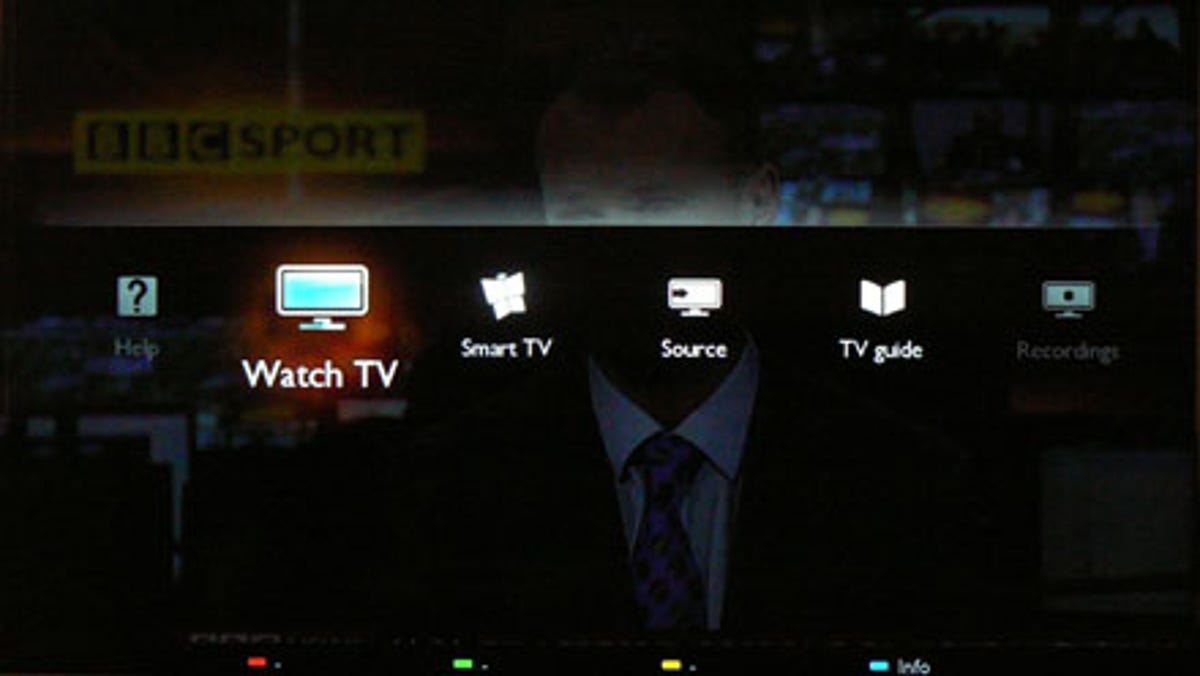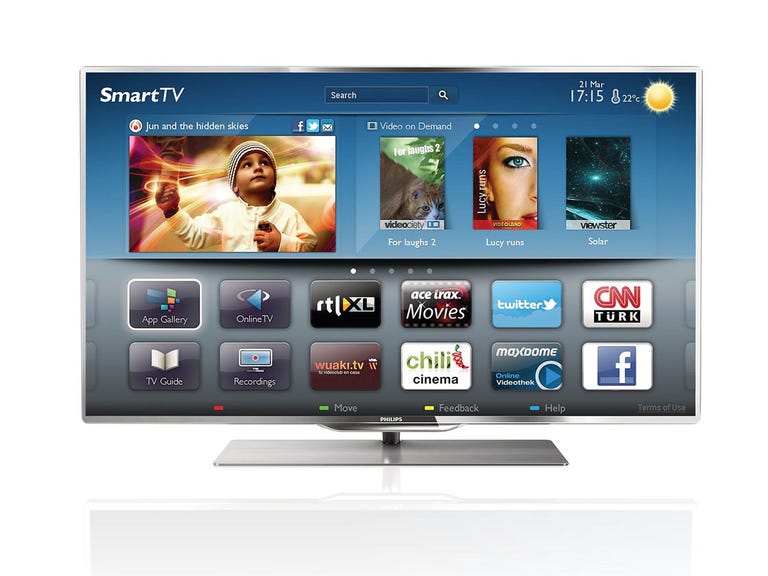 Why You Can Trust CNET
Why You Can Trust CNET Philips 46PFL7007 review: Philips 46PFL7007
The 46PFL7007 manages to combine very stylish looks with great picture and sound quality.
The Philips TV division has gone through some pretty drastic changes recently. It's been spun off into a joint venture between Philips and Chinese company TPV. The latter was previously best known for producing computer monitors.
The Good
The Bad
The Bottom Line
The 46PFL7007 is one of the latest fruits of the joint venture's labours and fills a gap between the mid-range and high-end models in Philips' current lineup of TVs. Priced at around £1,300, it's got a stylish metallic design, Ambilight technology, 800Hz processing power and 3D support.
User interface and EPG
Philips has overhauled the user interface it employs on this year's models. The new system is based around a series of scrolling banners that run across the middle of the screen, which have large icons for features such as the TV guide, smart TV features and set-up screens.
There's also a handy secondary menu that you can access via the options button on the remote that gives you quick access to other settings, such as the picture and sound presets. I very much like the way the TV can automatically detect the type of equipment you've got attached to its HDMI ports and then name each input automatically.

The menu system looks attractive and there are neat scrolling animations as you move through the different options. Despite the fact the TV uses a dual-core processor however, navigating around the various screens feels quite sluggish and accessing certain settings, like the advanced picture controls, is annoyingly long-winded.
The EPG has also gone through some changes. It uses a pretty traditional horizontal timeline layout, but it shows more programmes on the screen in one go than older Philips TVs. Another nice touch is that the channel logos are displayed next to each channel in the EPG, and also appear when you switch between channels using the zapper.
The EPG is far from perfect though. It doesn’t include a video preview window and it also blanks all audio when you call it up, so it's very intrusive to use if you're watching a programme, but just want to check what's coming up on other channels later.
Digital media and Internet features
Philips has given its Net TV system a bit of a spruce with a new user interface and the addition of some extra apps. You'll now find the Acetrax and Blinkbox movie rental services sitting alongside the likes of BBC iPlayer, YouTube and Viewster. Netflix and 4oD are due to make an appearance in the future, although there's no definite timeline for this yet.
You do get a full Web browser -- based on Opera -- too, but it doesn’t support Flash for online videos. Philips has included a clever two-sided remote though with the TV that has a keyboard on the bottom. This is very handy for typing in Web address passwords and the like on websites. The remote has a sensor built in, which knows which way up you're holding the zapper and automatically disables the buttons on which ever side is pointing down.
The set also includes support for Skype, although you need to shell out extra for an optional camera to make use of this. At around £100, it's quite pricey.
The Net TV system is a definite improvement over what was available on last year's models, but it's still a long way off similar systems from the likes of Sony, LG and Samsung in terms of content and the general user friendliness. The Facebook app on NetTV, for example, is very poor. It simply shows the full Facebook website, which isn’t easy to navigate using the remote.
On the plus side, there are some other useful smart features. If you attach a hard drive to one of its USB ports (it has to be at least 250GB in size) you can pause live TV or schedule recordings. There's only a single tuner, so you can’t watch one channel while recording another, but it's still a feature that some people may find useful.
The on-board media player is also quite good. It had no problems playing back my test MKV, DivX and Xvid files, and supports JPG pictures and MP3, AAC and WMA music tracks. All the formats which played from USB keys also worked when they were streamed across a network from my hard drive. The folder navigation is a tad sluggish, but the transport controls are nice and responsive.
If you download the MyRemote app for your iOS or Android device you can also stream the current channel from the TV's tuner directly to your portable device, which is a great idea even if there is quite a bit of a delay between requesting the stream and it starting to play on your device.
Design and connections
Philips has a knack of churning out great-looking TVs and it's worked its magic again on the 46PFL7007. This model looks very luxurious thanks a narrow metallic bezel that runs around the outer edge of the screen, as well as the brushed aluminium effect used on the stand. Despite the presence of two LED strips on the back of the set to facilitate the Ambilight feature, the TV is still quite slim, measuring around 22mm deep.
Like some of Philips' previous models, the stand houses the set's sound system, and so connects back to the TV's chassis via a small cable. Even more ingenious is that by rearranging the stem and exchanging a few bolts, the stand can double as a wall mounting bracket for the TV. This means you don’t lose the audio feature if you prefer to have your telly hanging on a wall rather than perched atop a unit.
The TV has excellent connectivity -- you get five HDMI ports, whereas most models of this size from rivals manufacturers offer only four. There are also inputs for VGA, component and Scart, although the last two have to be made via small adaptor cables -- something that's now pretty common on today's slimline TVs. Naturally there's an optical digital audio output for feeding audio from the Freeview HD tuner to an external amp too.
Philips has also been generous when it comes to USB ports, providing three in total. There's both Ethernet and Wi-Fi too, for the smart TV and media streaming features, so really you couldn't ask for more in terms of available connections.
Audio quality
The quality of the audio that this model produces is miles ahead of most of the competition. The reason is simple. Rather than trying to wedge tiny speakers into the set's chassis, Philips has instead opted to build the audio system into the stand. As a result it's being able to kit it out with larger speakers.
The speaker drivers used here are 20w each, which is double the rating of most integrated speakers on LG and Samsung models. They connect back to the set via a short cable that runs up through the centre of the stand. As the stand also doubles up a wall bracket, you won't have to switch to smaller integrated speakers -- as you do on Sony's HX853 model, which also has speakers integrated into its stand -- if you choose to wall mount the TV
Thanks to the larger speakers, this set has much richer and more full-bodied sound than the vast majority of its rivals. This gives much more punch to bass on music tracks or low frequency rumbles from explosions and car crashes in action movies. Dialogue also sounds crisper, and there's generally much better separation between sounds compared to models with smaller, integrated drivers.
2D Picture quality
Philips has packed plenty of picture processing technology into this set. It uses micro-dimming technology to try to help it deliver deeper black levels. This isn't local dimming though -- rather it uses edge LED lighting combined with some clever software which constantly monitors the pictures to control the backlight, picture brightness and contrast to achieve its results.
On top of this, it also has Pixel Precise HD processing, which is a step down processing from the Pixel Perfect HD system found on the company's most expensive sets. Nevertheless, it does include 800Hz motion processing, which is achieved by adding motion interpolation and backlight blinking on top of the set's native 200Hz panel to combat blur and judder.
For the most part, this TV's pictures are very impressive. Both HD and standard-definition sources tend to look very sharp with beautifully defined edges that don’t look overly processed. It also does an excellent job on the colour front, delivering a wonderfully wide colour palette that has a naturalness which many lesser TVs lack. I really like the Ambilight feature too; it helps to make on-screen images just seem that bit more immersive.
Its black level performance is also very good. With the dynamic backlight setting switched to 'best picture' there's also most no bleeding or clouding from the backlight visible at all. In all the other modes though, there was a patch of clouding visible on the middle of the left-hand side of the display on my sample, although it wasn't really any worse than the competition in this regard. For the most part the best picture setting works enormously well anyway, but you do get some subtle crushing of blacks and shadow detail now and then.
There are a couple of other issues to bear in mind too. Philips' motion processing system doesn’t seem to be as good as the competition's, as even on the minimum setting it has a tendency to cause flickering around the edge of moving objects. This happens with most picture processing systems to some degree, but I felt it was worse in this particular instance.
Although the various picture processing options really can produce very good results across a range of different inputs, they're quite fussy to use. Often you need to have very different settings for SD and HD broadcasts, otherwise the processing engine boosts many of the weaknesses in SD broadcasts rather than covering them up. For many people, constantly flicking between settings will just be too much hassle.
The set's viewing angles aren’t all that wide, either. If you move off axis by a significant amount, blacks start to take on a bluish tinge and brightness and contrast drops off significantly. It's similar to most of Sony's sets in this regard.
3D picture quality
Unlike the slightly lower-range PFL6007 model, the 46PFL7007 uses active 3D technology, which delivers full HD images to each eye. The set comes with only a single pair of 3D specs in the box, but the price of active 3D glasses has fallen substantially, so you can now buy extra pairs for a little over £20 online. The glasses also have a special dual-screen gaming mode that allows both players to enjoy full-screen gaming.
This model generally does a good job with 3D content. It automatically boosts brightness levels in 3D to counteract the dimming effect of the active glasses, so pictures retain plenty of punch. It also produces a good sense of depth, something which its high sharpness levels help to achieve.
Crosstalk does rear its head now and again, which can be a tad distracting. The increase in brightness levels also makes backlight bleeding a tad more noticeable when you're viewing 3D movies with the lights turned down low.
Conclusion
The 46PFL7007 is a cracking looking TV that produces some astoundingly high-quality pictures. It also has an excellent sound system built into its stand that kicks out much better audio than you get from most TVs in this price bracket. Only the lacklustre smart TV system and overly fussy picture processing stop it from achieving an even higher mark.


